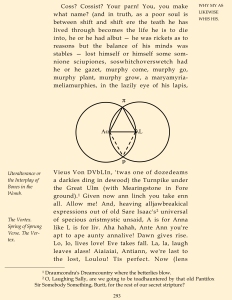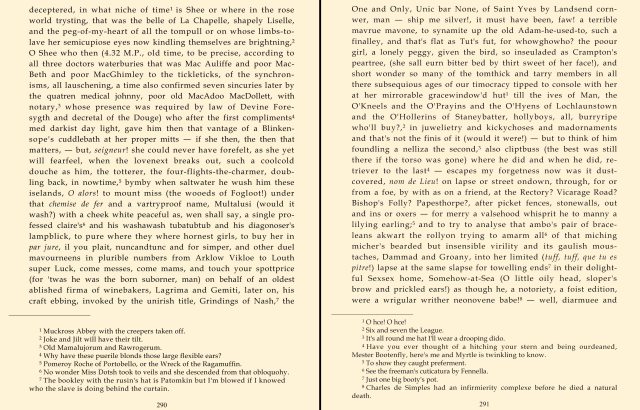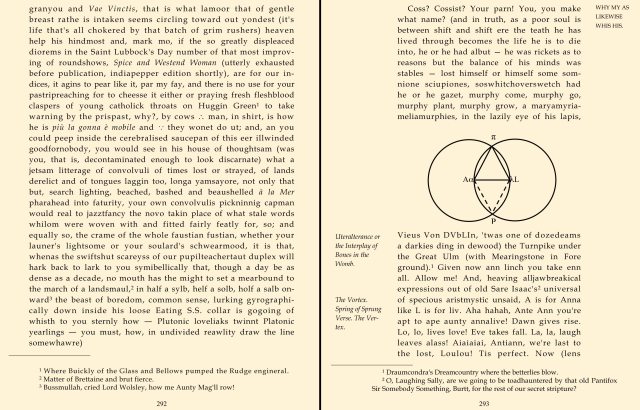Another four minutes of animation:
The above clip covers a single paragraph from Finnegans Wake – the one starting near the bottom of p. 172 and ending near the top of p. 174 in most editions. Parts one and two are embedded in the previous blogpost, which also discusses this project’s genesis and the collaboration with Mike Watt.
While I hope that viewers will find the animation here fun and entertaining, I especially hope they find it illuminating. This paragraph contains only two sentences, the second of which is nearly a page-and a-half long, and while its actual word-distortion is fairly tame by comparison with other parts of the book, readers can still get get dizzy just trying to parse out the syntax. Joyce does this quite a lot in Finnegans Wake – often burying the subject and verb deep in a sentence’s middle amid a polyglot of modifiers, prepositions, subordinate clauses, parentheticals etc. – so my priority with this sentence was to demonstrate its basic structure without compromising any of its spectacular phantasmagoria.
Another feature I hope will prove instructive is my inclusion of the various hieroglyphs Joyce created as thematic building blocks for the Wake:
 One can think of these glyphs quite literally as “characters” – not only in their typographical sense: e.g. “280 characters per tweet max,” but in their dramatic sense as well: i.e. “players in a story.” For the record, Wake scholars generally refer to them as sigla, a plural Latin word basically meaning “characters.” Its singular form is siglum.
One can think of these glyphs quite literally as “characters” – not only in their typographical sense: e.g. “280 characters per tweet max,” but in their dramatic sense as well: i.e. “players in a story.” For the record, Wake scholars generally refer to them as sigla, a plural Latin word basically meaning “characters.” Its singular form is siglum.
The “star” of part three, obviously, is the fifth siglum from the left, the one that looks like a square missing a side. This is the symbol Joyce used in his notebooks, letters, manuscripts etc to denote his autobiographical counterpart in the Wake and protagonist of chapter seven: Shem the Penman. This little character afforded me the opportunity to literally dramatize Shem’s exertions as he wards off vilification and scandal, and in doing so, I found myself deliberately borrowing images from the video games of my childhood – Space Invaders, Pac-Man, Asteroids, Missile Command, etc. Much like Finnegans Wake itself, these games were by their very nature studies in overwhelm, and their stories never ended happily. Part of me wanted to lift letters from the pile at the end to spell “game over” rather than “end of part three.”
But the chapter is far from over, and there is much left to depict as well as blog about. WordPress unfortunately doesn’t allow for special font uploading, so I can’t write about the sigla here as I’d like to. A real shame: They’re an extremely helpful tool for mapping one’s way through Finnegans Wake, so my plan is to eventually put up a series of youtube tutorials – similar to my thunderword pronunciation guides – discussing each of these glyphs/characters/sigla in detail.
In the meantime, enjoy the third Shem installment.
—JoyceGeek












